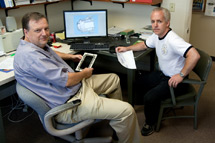
Handy Links
SLAC News Center
SLAC Today
- Subscribe
- Archives: Feb 2006-May 20, 2011
- Archives: May 23, 2011 and later
- Submit Feedback or Story Ideas
- About SLAC Today
SLAC News
Lab News
- Interactions
- Lightsources.org
- ILC NewsLine
- Int'l Science Grid This Week
- Fermilab Today
- Berkeley Lab News
- @brookhaven TODAY
- DOE Pulse
- CERN Courier
- DESY inForm
- US / LHC
SLAC Links
- Emergency
- Safety
- Policy Repository
- Site Entry Form

- Site Maps
- M & O Review
- Computing Status & Calendar
- SLAC Colloquium
- SLACspeak
- SLACspace
- SLAC Logo
- Café Menu
- Flea Market
- Web E-mail
- Marguerite Shuttle
- Discount Commuter Passes
-
Award Reporting Form
- SPIRES
- SciDoc
- Activity Groups
- Library
Stanford
Around the Bay
Bringing Power to the International Linear Collider
(Photo by Nicholas Bock)
Measuring in at more than 30 kilometers, the proposed International Linear Collider would be the longest particle accelerator ever built, providing physicists a better view of subatomic world than ever before achieved.
But becoming the biggest isn't easy. The ILC's unprecedented scale presents plenty of challenges, and more than 200 labs and institutions around the world are collaborating to make it work. At SLAC, accelerator physicists Chris Adolphsen and Chris Nantista are working on one point that has proven to be particularly prickly: figuring out how to provide the accelerator with the power needed to drive the machine's high-energy particle collisions.
At most linear accelerators, this power is provided by klystrons—devices that generate radio frequency waves to propel charged particles from one end of an accelerator cavity to the other. Klystron technology itself is nothing new. It has been around for nearly 70 years, and used in particle accelerators for almost as long. In the meantime, labs around the world have come up with no shortage of methods for coupling klystrons to accelerators. Expanding any one of these models to the ILC scale, though, presents a unique challenge.
One of the biggest concerns is cost. The current ILC plans call for two parallel tunnels—one for the accelerator cavity and associated cryogenics, the other for the klystrons and their power modulators. The biggest selling point for the two-tunnel approach is reliability. Technicians would be able to access the klystrons even during accelerator operation, ensuring that any problems that might arise could be fixed without having to shut the whole machine down. But digging one 30 kilometer tunnel 100 meters underground would be pricey on its own. Digging two would be considerably more expensive.
"The goal here is to explore different options for bringing the cost down," said SLAC accelerator physicist Chris Nantista. "One idea for doing this is to revisit this idea of two tunnels and see if we can't go to one."
Going to one tunnel is no easy feat. Aside from limiting access to the klystrons, getting everything into a single tunnel can be a pretty tight fit. Worse, the klystrons would generate a lot of heat, which would have to be cooled by piped water and air brought from and returned to the surface.
The creators of SLAC's linac got around this problem by bringing the klystrons to the surface, placing them 8 meters above the accelerator tunnel at 12 meter intervals. It's a good setup. The klystrons are accessible and most of the heat they produce simply dissipates into the air. The structure that houses the klystrons is the second longest building in the world, after the Beijing airport. Building something nine times longer to house the ILC klystrons would be costly.
So Adolphsen came up with a different idea: keep the klystrons above ground, but put them into groups of 60 or 70. The power from each cluster would be channeled into giant waveguides, with smaller waveguides branching off every 38 meters to feed into the accelerator cavity. By this method, the radio frequency power produced would be distributed 1.25 kilometers in either direction, providing 2.5 kilometers of coverage per cluster. Compared to the current plan, the klystron cluster model could skim as much as $300 million from the ILC construction costs.
"With the clusters, you get two savings," Adolphsen said. "One from getting rid of the tunnel, another from making the cooling system much simpler."
The cluster model brings challenges of its own. The main waveguides carrying radio frequency waves from the klystron clusters would need to carry more than 300 megawatts of power. Figuring out how to combine, transmit and distribute this much power efficiently could be difficult.
Other ILC collaborators have proposed alternative single tunnel models. A group of researchers at Japan's KEK lab is pitching a plan that would put smaller, less powerful klystrons in the same tunnel as the accelerator cavity. The arrangement would make up for the klystrons' inaccessibility by making them more reliable.
Later this year, the ILC's Global Design Effort committee will hold a meeting to review the two design options. In the meantime, Adolphsen and Nantista will continue working to test the feasibility of the klystron cluster design. Over the next year, they will construct a 10-meter long prototype of the waveguides that would be used, along with prototypes of a component called a coaxial tap-off—a device designed by Nantista for getting radio frequency power in and out of the main waveguide. In all, the prototypes will provide an opportunity to test whether the setup will be able to handle the power levels that would be involved in a full-size version.
"We have to do some demonstration to build confidence that this will work," Nantista said. "I hope it does."
—Nicholas Bock
SLAC Today, September 4, 2009
